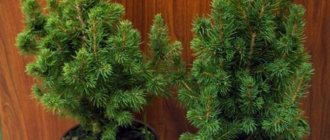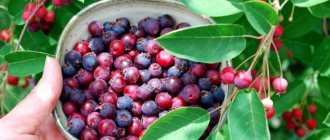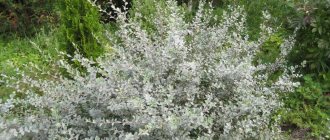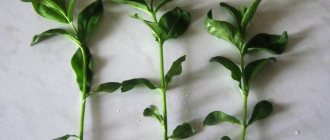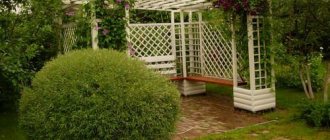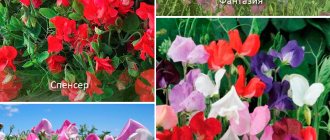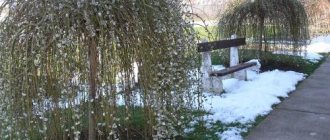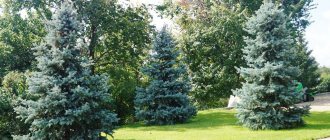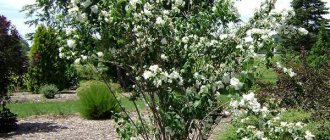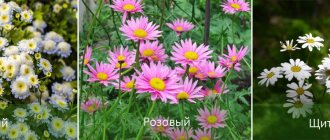Description of the species
The shape of these trees is mostly conical, but there are also spherical representatives of this species. The needles are bright, green, gray, blue, and also come with white young growths. It is usually short, hard, and prickly. A tree that grows in the wild can reach 15–18 m in height, but the size of cultivated varieties is much smaller - up to a maximum of 2 m.
Canadian spruce Daisy's White
In its shape, this variety resembles the well-known Konica. The needles of this tree are soft and bright green. The Christmas tree gains special decorative properties when new growths appear, which occurs in late May - early June. At first they are yellowish-white in color, later they turn green. In the spring, when the first growth appears in sunny weather, white needles tend to burn. Typically, the color of the second summer growth is green.
Canadian spruce Daisy White grows relatively slowly and reaches 0.8 m only by the age of 10. The recommended place for planting is sun or partial shade. The tree requires well-drained soil with optimal levels of moisture and fertility. In March, protection from bright sunlight is necessary. To ensure moist and loose soil in the tree trunk circle, mulching is carried out. To do this, you can use peat, mowed grass and other natural ingredients.

Daisy White is a beautiful evergreen tree. Due to its miniature size and summer decoration, a small unpretentious Christmas tree becomes a decoration of a heather garden, and also harmoniously combines with other types of dwarf conifers and herbaceous plants.
Common varieties
The most common varieties of very original gray spruce: Konika, Solnyshko radiant, Pendula, Rainbow End, Sanders Blue, Daisy and Alberta Globe. They are all similar to each other in their short stature and shape, but, of course, each variety has its own characteristics.
Konika
The most popular and most common variety is Konica. And this is not surprising, because it has a simply charming appearance that can decorate any landscape. With its shape, this spruce resembles a narrow cone. She has a very thick crown. The needles on its branches are bluish-green, soft to the touch, radial, and short. The root is a taproot, quite compact, most of it is located close to the surface of the earth, which must be taken into account when loosening the soil.
Did you know? The first time the New Year tree was decorated was in Riga in 1510.
This spruce variety grows slowly. Over the course of a year, it increases by only 3–4 cm. With good care, an adult plant can reach 3 m in height, although, as a rule, representatives of this variety are no higher than 1 m. Konica is simply irreplaceable for creating hedges. Its main drawback is the severe burning of the crown under the influence of sunlight in the spring.
Video: Konica spruce
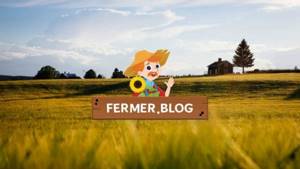
The sun is radiant
This variety, like many other Canadian spruce trees, grows rather slowly and, as a rule, grows no higher than 1 m. This variety is a cone of a perfectly regular shape. The crown is dense and has high decorative properties. The needles on fresh shoots are light yellow, later they turn blue-green. Spruce Sun radiant is undemanding in care and grows on different soils. To improve its appearance, it is advisable to plant it in places accessible to sunlight.
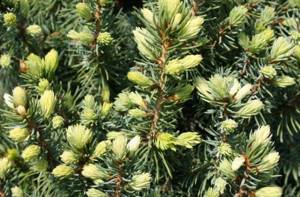
Alberta Globe
The Alberta Glob variety is a mutation of Konica, but differs from it in appearance. This is an evergreen shrub with a spherical shape. Young needles are yellow-green, then they become bright green. This variety grows very slowly. The diameter of this unusual ball in adulthood is 1 m.
Learn how to grow a spruce hedge.
Alberta Globe loves to grow in the sun, but also feels fine in the shade. The rhizome is very close to the surface of the earth, so the soil under it must be constantly moistened. Better yet, mulch the area around the plant. Alberta Globe spruce looks very advantageous in oriental compositions, and it is also often grown in pots.
Video: Alberta Globe spruce
Daisy
This miniature tree resembles the Konika variety in its shape and color. Its growth is very slow. In 10 years it grows only up to 80 cm. Daisy’s needles are short, soft, and green, like Konika’s. Young shoots that appear in spring are yellowish-white, later they turn green. The next summer growth is the same in color as the old branches. Since white young needles can fade, they need to be protected from spring sunlight.
Important! When combining different types of coniferous trees, you need to take into account their relationship to the frequency of watering.
The soil in the places where it grows should be drained, rich in nutrients, and also moderately moist. To protect the surface of the hole in which the tree grows from drying out, it is advisable to mulch it with peat or grass. The Daisy variety, due to its high decorative qualities, is used to create a heather garden, and is also combined with other dwarf coniferous trees in group plantings.
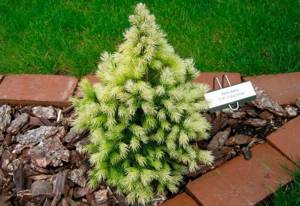
Daisy grows well in areas with varying light levels, but of course does best in full sun.
Sanders Blue
Trees of this variety are slightly narrower than Konika, but have the same conical shape. But Sanders Blue's height is very small; in 10 years she grows to only 70 cm . The tree has many shoots, the needles on them are short and thin, silver-blue in color. Young needles are brighter than old ones.
Read the description of the Sanders Blue spruce.
Sanders Blue needs good lighting, but for the first few years it needs to be protected from burns received under the spring sun. It is better to choose soils for it that are slightly acidic, moderately moist and well-drained, where stagnation of water is excluded.
Video: Canadian spruce Sanders Blue
Rainbow End
This is a miniature plant, shaped like a cone. Its needles have a beautiful green color in the spring, and become bright yellow in the summer. The tree grows very slowly and, as a rule, does not exceed 1 m in height. Rainbow End needles are short and soft.
Fresh shoots are light green in color.
Botanical description
White spruce is a fairly tall tree, reaching up to fifty meters in height. The size of the trunk is about one meter in diameter. Dense branches form a dense, cone-shaped crown. In young trees, the branches are directed upward at an angle, while in mature trees they are directed straight down. The bark of the trunk can be smooth or covered with small gray-brown scales. The shoots of the plant are usually much lighter than old trees, and sometimes they are completely white.
The buds are not resinous, light brown, 3-6 mm in length. Coniferous needles grow from 8 to 18 mm in length and 1.5 mm in width, and have a tetrahedron shape in cross-section. The needles are green on all sides with a bluish tint. The needles stay on the tree for 5-7 years , and in some cases up to 11 years. The cones are cylindrical, ovoid, up to 7 cm long and 1.5-2.5 cm wide. The scales of the cones are thin and soft, solid at the top.
The seeds are small and have a light wing that is three times their length. Spruce is sometimes found in the mountains at an altitude of 1.5 km. The evergreen tree tolerates severe frosts well and is indifferent to drought. It grows on literally all existing types of soil. Unlike Norway spruce, it tolerates gas pollution and smoke in the atmosphere well. In culture, this species is recommended for both single and group plantings.
How to plant
Canadian spruce is propagated by cuttings, seedlings or seeds that ripen in cones. If you don’t want to wait a long time, the easiest way is to buy a seedling from a nursery.
The spruce for planting should be selected taking into account the following points:
- the shape of the seedling must correspond to the variety you have chosen;
- the color of the needles should be bright and rich;
- branches cannot have any physical defects;
- the rhizome must be developed, with many sprouted roots, not knocked down into a total mass;
- you need to choose roots covered with a layer of soil and wrapped in a net or damp cloth.
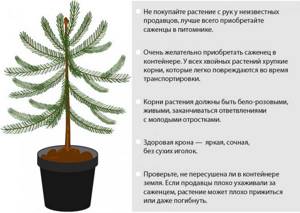
Planting of gray spruce occurs in the following sequence:
- Choose a suitable location that is well lit and protected from drafts.
- Dig holes twice the size of the roots. The distance between plants should be at least 2 m.
- Pour broken brick or expanded clay onto the bottom to create drainage. Its layer should be about 20 cm.
- Fill the hole with soil or compost, filling it about halfway.
- Place the young tree in the hole so that the root collar is above the ground.
- Cover the seedling with soil.
- Press down a little, just be careful not to break the roots.
- Fill one bucket with water and sprinkle mulch (peat, leaves, grass) on top.
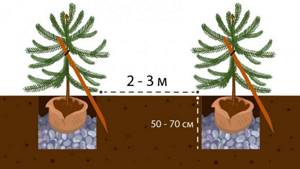
Landing rules
At home, spruce cannot be grown to adulthood, since they will only be seedlings. It can be used as a houseplant if it spends the winter on the balcony. After four years, the tree must be planted in open ground.
Soil for planting:
- Two parts of garden soil;
- Part of peat;
- Two parts of turf land;
- One part sand.
The place for growing must be carefully chosen. It is advisable that this be a shady corner to avoid waterlogging of the soil and being at a strong elevation.
Close proximity to groundwater has an extremely negative effect on the appearance and growth of Canadian spruce. It is also important to protect the plant from the wind, since domesticated species of live spruce are more demanding in terms of conditions.
If a pine tree has an open root system, then it must be planted in open ground at any time except winter. When the system is closed, it is in the fall or spring. It is better to transplant plants at the dacha on a cloudy day. This condition is important so that the needles do not get burned.
Further care
Although gray or white spruce is not very demanding to care for, its basic principles must be remembered and followed in order for the tree to grow and develop properly. Proper watering, pruning and protection from the spring sun will help grow your plant beautiful and resistant to environmental conditions.
Video: caring for Canadian spruce
Watering and moistening
Coniferous trees are resistant to drought, but cannot tolerate excess moisture. That is why they are planted in places where groundwater is no closer than 60 cm from ground level. Young plants need plenty of watering to help them develop roots. And then you need to look at the weather.
Important! The first couple of years, replanting Canadian spruce is very harmful for its growth and development, because if it is poorly rooted, it may not take root in a new place.
If the summer is too dry, you can water the young spruce trees once a week using one bucket of water. For older trees, you need to take two buckets. They are also very good at regularly spraying the crown with water, which makes the needles look brighter and healthier. If it rains often in the summer, it is quite possible to do without additional watering.
Sun protection
Since young dwarf spruce trees can fade in the sun, they need to be covered in the spring. And it is best to plant them in a place where there are large trees nearby with a not very dense crown, through which diffused sunlight can break through.

Trimming and pinching
To make the crown more voluminous, you can pinch out young shoots of Canadian spruce. This tree practically does not need pruning, because by nature it has a very beautiful shape. But to create an interesting silhouette that will successfully complement any composition, you can trim each variety of blue spruce to your liking. And, of course, all damaged and diseased parts of the tree that cannot be cured and restored must be pruned.
Video: pruning and shaping spruce
Cultivation of white spruce: planting, care and propagation
The tree can be planted in dimly lit places . If the choice is between an open area and a shaded one, then preference is always given to the second. Spruce is afraid of direct sunlight, because on hot summer days it easily becomes a victim of burns. This is also relevant in a clear winter or spring with little snow, when warm rays begin to actively warm the earth. Of course, you can protect the spruce by constructing a shelter that protects from ultraviolet radiation. But it is much more rational to plant it in the shade so that such a problem does not arise.
The advantage of this species is that it can withstand even strong winds. This makes the tree a good option when windbreak is needed. Unlike the European variety, the “Canadian” variety is insensitive to smoke and various gases.
In order for the plant to please with its decorative properties, it is better to plant it in loamy soil or enrich it with humus in advance. Infertile, dry, calcareous or simply rough soil will not work - the tree will take root, but will grow frail and unsightly.
Do not forget that gray spruce loves moisture-loving, but in no case waterlogged soil. It must have a drainage layer. And it makes sense to water only in the absence of rain for a long time .
Plant propagation
If there is a desire to propagate Canadian spruce, then this must be done by cuttings. The best time for the procedure is the beginning of summer. Then the place where the cutting is cut will definitely have time to be overgrown with callus before the autumn cold, and by next spring it will successfully take root.
But you must follow several recommendations:
- as cuttings it is worth taking the lower mature branches, the length of which is approximately 10–15 cm;
- the branch should be separated from the mother tree with the so-called “heel”, otherwise the cutting will die;
- fresh cuts are treated with a growth stimulator, after which the remaining solution can be diluted with water and used for watering pots with planted cuttings;
- The planting itself consists of deepening the place of the processed cut into a special substrate, to a depth of 3 cm;
- During the entire rooting period, it is necessary to carefully monitor the condition of the substrate: it should not dry out, but at the same time, excessively generous watering will also not bring any benefit.
In landscape design
Almost all of the presented varieties of spruce are quite popular in landscape design. Canadian spruce is very attractive both in single plantings and in group compositions. Due to its very slow growth, it is rarely planted in flower beds, but when it reaches the desired height, the spruce looks great in mixborders.
Did you know? Each fir cone contains about 100 seeds.
When decorating gardens, city parks, for planting on terraces and near houses, this plant is used with pleasure, creating a unique landscape. Due to the resistance of dwarf varieties to the wind, as well as their dense crown, hedges are planted from them to protect flowers and shrubs.

Planting any variety of Canadian spruce is a great idea both when growing a garden and when creating original parks for walking within the city. In addition, Canadian spruce adapts well to any conditions and is very easy to care for.
Growing at home
Growing Konica at home is quite difficult. The most important thing here is temperature. Because the plant simply may not withstand high winter temperatures.
The lowest temperature is 10 degrees.
In winter, pots of spruce must be taken out onto the balcony, and it is important to constantly maintain the required level of humidity, avoiding drying out. It should be watered no more than once a week, otherwise the needles will turn dark purple. If there is not enough moisture, then the needles, on the contrary, will turn yellow and crumble.
The following fertilizers should be used:
- Epin;
- Hall;
- Zircon.
Because the plant must receive the required amount of nutrients. In dry times, the crown is sprayed with water to restore the moisture balance.
Canadian spruce Sanders Blue
Sanders Blue is a conical decorative variety, slightly narrower than Konika. It has bright blue needles. This is a real dwarf. Its growth is so slow that by the age of 10 it barely reaches 70 cm. The young shoots are quite numerous, have thin and short needles, which gives the Christmas tree a silvery-blue hue. Young needles always look brighter than old ones.
Canadian blue spruce grows well in a sunny location. Prefers moist, slightly acidic soil with good drainage. Differs in frost resistance.
However, during the first years after planting it needs protection from ultraviolet sunlight. Does not tolerate waterlogging well. In dry periods it requires artificial irrigation. Like other spruce trees, mulching is recommended.
It is worth considering and remembering that the tree is susceptible to infection by pine spider mites. In this regard, it is very important to have an insecticide on hand in order to treat the tree in a timely manner.
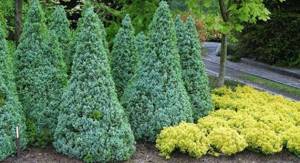
Unfortunately, the tree is not yet very popular in central Russia. But it is worth saying that if you follow the simplest agricultural techniques, you can get a wonderful small specimen of an ornamental Canadian spruce, which is perfect for a rocky hill, a small garden or a winter garden, where its bizarre shape and color can amaze even experienced gardeners.
How to grow?
Experts in the field of growing spruce trees recommend planting them responsibly. Despite the unpretentiousness of these plants, there are nuances that are worth considering.
Selecting a location
A place for a spruce tree is usually chosen based on one of the principles. The first is that the spruce is purchased as a single New Year's tree, which should take pride of place on the site and be available during the holidays - so that it can be decorated and danced around. The Christmas tree should be visible from the windows of the house, and even better if it is visible from the street.
Another case is when one or more fir trees are purchased to decorate a site as part of a landscape composition. This is usually done by more experienced gardeners. They carefully ensure that the conditions in a particular area contribute to the normal growth of spruce - this is the correct soil composition, optimal moisture, lighting, because only when an optimal environment is created will the spruce bloom in all its glory. They also take into account the presence of other plants in the neighborhood - the spruce should not block the light for light-loving specimens. For example, it will be too dark for lawn grasses under its branches.
It is important to take into account the requirements of a particular variety of Canadian spruce and create the most comfortable conditions for it, because there are more and less capricious varieties. The basic rule is typical for most of them: for the growth of a beautiful dense spruce crown, the area must be well lit, and in early spring the tree must be protected from the rays in order to prevent burns
Landing
To prepare a place for the Christmas tree, the soil should be dug to a depth of 40 cm and fertilized. It is best if rotted manure is applied at the rate of 10-20 kg per 1 square meter of area. You can use a combined NPK fertilizer, its dosage ranges from 80 to 100 grams per square meter. Sandy soil will not have the best effect on the growth of a tree, so it is better to dilute it with fertile loam or turf soil.
Spruce with an open root system is transplanted in autumn or early spring. If the process does occur in the summer, then it is better to choose a cloudy day for this. The tree is actively watered for two weeks, and then a comfortable shade is created for it while it takes root.
Watering
Young trees require abundant watering - 10-12 liters of water
This is especially important in the fall, since they may not survive in winter due to lack of moisture, which is much worse for them than cold weather. Adult spruce trees do not need as much water as young shoots
Still, glauca is considered a drought-resistant tree.
Top dressing
Canadian spruce loves to mulch the soil; this is an important component of caring for it. Thanks to this procedure, the soil retains moisture better. In addition, due to mulching, weeds do not grow as actively and do not take nutrients and water from the Christmas tree. To mulch, use sawdust, peat or tree bark.
Trimming
Many gardeners, for decorative purposes, prune overly protruding or dried out black branches, although glauca by nature tends to maintain a beautiful shape. To maintain the natural beauty of the tree, pruning once a year is sufficient. During this process, elements that have lost their appearance are removed, and if necessary, the crown is slightly adjusted.
Growing in a pot
Growing Canadian spruce in a pot is a fun and enjoyable process. A small tree can please the eye and decorate the interior. For indoor coniferous plants, you will need acidic soil. Buy ready-made soil for pine needles or mix one part of a standard soil mixture and soil brought from a coniferous forest.
Due to the scorching sun, the branches of a potted spruce may turn yellow, and they will no longer return to their previous appearance. To prevent damage to the remaining branches, you need to normalize the conditions of the plant and spray it with bioregulators, which are used as emergency aid. If the soil is not sufficiently oxidized, the needles may wither and wrinkle. This can be stopped if you replace the top layer of soil with spruce soil, while avoiding exposing the roots and maintaining the ground level.
Canadian spruce, planting and care
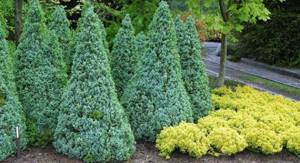
Spruce is a good solution for landscaping a site. Throughout the year, such a tree will decorate the garden or courtyard, making it bright and beautiful. The evergreen beauty is a godsend for landscape designers. After all, it lends itself perfectly to crown formation, especially decorative forms. And this allows you to create real masterpieces of design art on the site. In this article we will look at the most popular spruce - Canadian spruce, which occupies a special position in the entire family due to its decorative properties.
- Canadian spruce Conica
- Propagation by seeds
- Selection of seedlings
- Watering
Features and description of Canadian spruce
Canadian spruce belongs to the pine family and is one of its most common species. This spruce has several other names. It is often called blue spruce or white spruce, and is also known as glauka spruce. North America, namely Canada, is considered the homeland of spruce. This is where the very name of the coniferous tree comes from. Spruce was brought to Europe in 1700, since then it has spread throughout the continent, including being cultivated in Russia.
This type of coniferous tree especially appealed to landscape designers, because Canadian spruce has many forms, including dwarf ones. And they are an ideal option for decorating a site.
Description of Canadian spruce:
- This type of conifer is a tall tree; its height can reach 25-30 meters. However, there are dwarf varieties that do not exceed half a meter.
- Canadian spruce has a regular conical crown shape, which is of decorative value.
- It grows especially quickly at a young age, in the first 10 years. And then the growth of the spruce slows down.
- In young spruce trees the branches are raised and tightly adjacent to each other, in old ones they are slightly lowered.
- The color of Canadian spruce needles is green with a bluish tint. Another name is associated with this - gray spruce.
- The needles are very short and prickly.
- Canadian spruce bears fruit after 10 years of growth. The cones have an oblong shape and are very decorative.
- Canadian spruce is a long-liver, its average age is 300-500 years.
- Winter-hardy and drought-resistant.
- Widely used in landscape design for landscaping, creating hedges and garden compositions.
- To date, 20 decorative species of Canadian spruce are known.
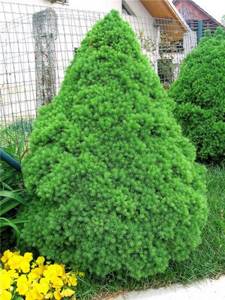
Canadian spruce is valued for its decorative value and is a special decoration of any site. In the presented photos you can note the features of using spruce in the design of the site.
Canadian spruce in a landscape composition
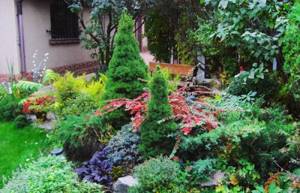
Growing Canadian spruce in containers
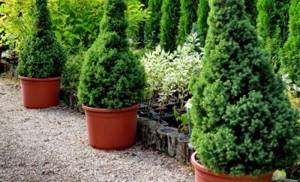
Canadian spruce in rocky gardens

Main varieties of Canadian spruce
Landscape design uses both the natural form of Canadian spruce and many decorative species bred specifically for landscaping areas. There are 20 decorative forms of Canadian spruce, which differ in height, color of needles and their individual characteristics.
Canadian spruce Conica
Canadian spruce Konica is the most common and popular spruce. Such love for this coniferous tree is caused by its size - this spruce belongs to the dwarf form and is an ideal solution for decorating a site. It can reach a height of 1.5-2 meters, rarely growing up to 2.5 m. It is possible to plant Konica spruce in open ground in stone gardens or in containers.
Spruce has a dense cone-shaped crown, so the main care for Canadian Konica spruce consists of shaping the shape of the needles. It is its ideal shape of needles that is of particular value for landscape design. This spruce is planted in open sunny places or in partial shade. Due to its properties and frost resistance, it is perfect for growing in the middle zone, but with the condition of shelter for the winter. It grows slowly, which is perfect for many gardeners.
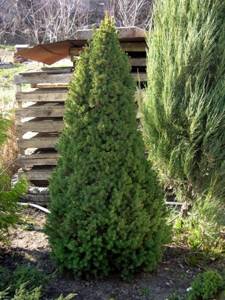
Canadian spruce Alberta Globe
Canadian Alberta spruce is also a dwarf form, ideal for landscaping. It has a spherical crown shape. The shoots of this tree are short with short needles on them. The needles are green. This variety of Canadian spruce grows slowly, with an annual growth of 2-4 cm. Excellent for growing in containers or for planting in rock gardens. The variety was bred in the Netherlands.
Canadian spruce Blue Planet
Such a Christmas tree is indeed a very small tree. Over 10 years, the diameter of the crown reaches only 20 cm. The crown has the shape of a ball, the needles are very short. It is distinguished by its silver-blue color. It is a good option for planting in containers, as well as for decorating alpine slides. It is imperative to plant it in sunny places, otherwise it may lose its bluish color in the shade.
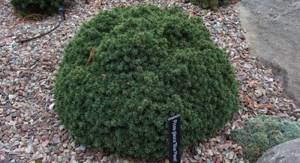
Canadian spruce Daisy White
The Canadian spruce Daisy white is very similar in appearance to Konica, since it comes from this particular variety of spruce. Its crown is cone-shaped. By the age of 10, it reaches a height of 80 cm. Daisy spruce has its own peculiarity - the first shoots have a yellow-white color, which then fades in the sun. Already in the second year the branches become green.
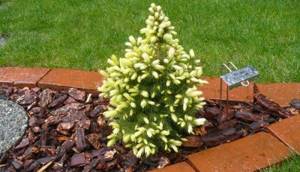
Canadian spruce variety Echiniformis
This is a low-growing variety of spruce that grows very slowly. An adult plant of Canadian spruce echiniformis reaches only 50 cm in height, and can grow up to 1 meter wide. It has a spherical crown of bluish-green color. Suitable for rock gardens or containers.
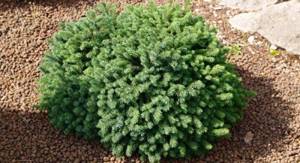
Canadian spruce Laurin
Refers to dwarf varieties of needles. It grows very slowly, growing by only 2 cm per year. By 10 years, the height is about 40 cm. It is distinguished by a narrow conical crown and bright green needles.
Canadian spruce variety Sanders Blue
Sanders spruce is very similar to the most popular variety, konica. It has the same regular cone-shaped crown and is a dwarf variety. A distinctive feature of this variety is the blue tint of the needles. Looks great in small gardens.
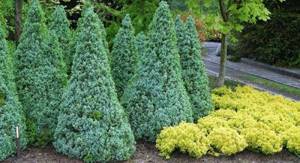
The above varieties of Canadian spruce are only part of the species diversity that are used in garden landscaping.
Methods of propagation of Canadian spruce
There are two main ways to propagate Canadian spruce - propagation by seeds and cuttings. Any of these methods is a rather labor-intensive and time-consuming process, since growing a Canadian spruce seedling is very difficult. It takes a lot of time and requires constant attention and care.
Propagation by seeds
This method is very difficult to use at home, since you will have to wait a very long time for the results. First you need to prepare the seeds. You need to take fresh ones - they will take root better. Seeds are collected from unopened cones. Then the best ones are selected and stratified. To do this, planting material can be placed in a mixture of sand and peat and refrigerated for 4-6 weeks.
After cold hardening, the container with the seeds is placed in a warm and bright place and watered abundantly. The best time for germination is late winter or early spring. When watering, be sure not to overwater the sprouts, otherwise they may begin to rot. Canadian spruce is planted in open ground only in the second year.
Reproduction by cuttings
Growing Canadian spruce from cuttings is also a lengthy process, but it is more reliable and gives good results. The best time to start rooting cuttings is June, as they have time to get stronger before winter. At this time, calluses appear on the cuttings, and the first roots appear from it only the next year.
- For cuttings you need to choose the right branches. Usually the mature branches at the very bottom are torn off from the mother tree. Their height should be approximately 10-12 cm.
- It is necessary to separate the cuttings correctly - make sure that the branch must have a “heel”, with a part of the mother tree. Without it, the young plant will not take root.
- Next, you can treat the planting material with growth stimulants, for example “Kornevin”. To do this, pour the solution into a jar and lower the cuttings there by 2 cm. You can keep them in the solution for 2 hours. After this, this solution can be diluted in water and used to water the cuttings.
- A mixture of peat and sand can be used as soil.
- The cuttings are buried into the prepared substrate by about 2-2.5 cm and covered with film, having previously been sprinkled with water. This must be done to maintain the required humidity.
- Be sure to monitor the soil moisture, it should not dry out.
- It may take 4-5 years to obtain a finished seedling.
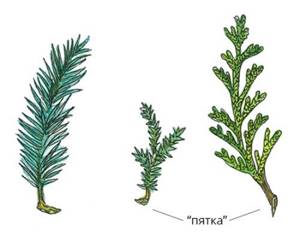
To obtain a beautiful and healthy coniferous tree in the future, it is imperative to carefully prepare before planting. Pay special attention to choosing high-quality seedlings and the place where you want to plant them.
Selection of seedlings
Most often, Canadian spruce seedlings are purchased from special nurseries or from professional gardeners who are engaged in breeding. When purchasing Canadian spruce seedlings, follow some rules:
- The needles should be thick and shiny without dried needles.
- Pay attention to the soil in the container - it should be moist.
- The roots should not protrude from the pot and the container itself should be large enough for the seedling to fully grow.
- If a seedling is dug out of the ground, pay attention to the roots. They must be safe and sound.
- If you grew the seedlings yourself, carefully dig them up so as not to damage the root system.

All varieties of Canadian spruce prefer to grow in sunny and open places. However, partial shade is also perfect. Shading is especially necessary for young spruce trees, which can get burned. Needles planted in the shade may grow slower and lose their natural needle color. The choice of planting location directly depends on the selected variety and your idea. Dwarf varieties are perfect for decorating garden paths and for planting in containers. Tall trees will be an excellent element of the design composition.
Soil selection and preparation
Excellent soil for planting Canadian spruce would be loam and soil rich in humus. Be sure to ensure that the soil is not too full of lime. Canadian spruce prefers to grow in well-moistened soils, so you need soil that will retain moisture. Drainage will help with this.
The process of planting Canadian spruce
Planting time directly depends on the planting material. If you purchased a seedling in a container, then the best time to replant it is from spring to autumn. When digging seedlings from the ground in a nursery - from mid-April to mid-May. The main thing is that the young tree in the new place has time to take root before the onset of cold weather.
Planting process:
- It is necessary to prepare a landing hole. Usually the recess is made one and a half times larger than the earthen lump.
- The root system must be watered abundantly.
- A special soil mixture is prepared or you can purchase it at a specialty store. For Canadian spruce, a mixture of fertile soil, compost and garden soil is suitable.
- Be sure to place a layer of drainage made of broken bricks or small stones at the bottom of the hole.
- Next, a seedling is placed in the hole and gradually covered with earth. You can fill in some soil, compact it and water it. Then add soil again.
- When pouring soil into the planting hole, remember that the root collar should not be buried.
- The soil around the plant does not need to be compacted, since the root system of Canadian spruce is close to the surface.
- After planting, the spruce needs to be watered abundantly.
- Then the tree trunk circle is mulched with compost or peat.
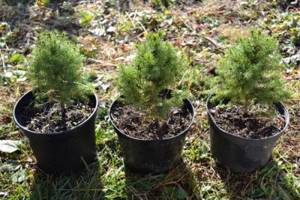
With proper and constant care, you will be able to grow a beautiful tree that will decorate your site.
Watering
Canada spruce trees are considered drought-tolerant trees, but this refers to mature plants with a strong root system. Young trees need infrequent but abundant watering. Typically, 10-12 liters of water should be used per tree. Particular attention should be paid to watering in the autumn, since this determines whether the tree will survive the winter. Most often, spruce dries out in winter not due to frost, but due to lack of moisture. Canadian spruce also likes to have its crown watered.
Mulching
Mulching helps retain moisture and also helps maintain a certain temperature. In addition, the presence of mulch slows down the growth of weeds. Earthworms usually breed under a layer of mulch, and they help loosen the soil. Therefore, you should not neglect this stage of care. You can use bark, sawdust, wood chips or peat as mulch. The mulch layer should be 4-5 cm.
Feeding Canadian spruce
Canadian spruce does not necessarily require fertilization, but you can feed it if desired. Fertilizers must be applied in the spring or no later than July. Compost or complex mineral fertilizers can be used as fertilizing. However, make sure that fertilizers do not contain large amounts of nitrogen. It is contraindicated for Canadian spruce.
Spruce pruning and crown formation
Most varieties of Canada spruce are ornamental forms, so they need pruning to form a crown. The spruce itself has a dense and regular crown, but some correction is necessary. This pruning is carried out once a season. Most often, sanitary pruning is carried out, during which dry and damaged branches are removed.
Canadian spruce diseases and pests
Diseases:
- Tracheomecosis. This is one of the most serious diseases of Canadian spruce. It is a fungal disease that affects the root system. Because of this, the plant does not receive the necessary nutrients. Young spruce trees are most often affected, causing the needles to turn red and fall off. The tree cannot be helped; it is dug up and burned.
- Schutte's disease. With this fungal disease, the needles turn black and fall off. You can cure a tree using a solution of copper sulfate.
- Rust. With this disease, yellow growths appear on the branches and the needles fall off. Special medications are used that are used for a month.
Pests:
- Bark beetle This pest feeds on wood and lives under the bark of the tree. There it lays its larvae, which subsequently also feed on the tree. A tree damaged by it can rarely be saved.
Canadian spruce dries out when there is excess or lack of moisture, as well as when planted in the wrong place. Especially when planted in a sunny place without shade. Therefore, it is important to properly care for the evergreen beauty to obtain a beautiful and healthy tree.
Canadian spruce is an ideal representative of conifers for landscaping. Due to the variety of forms and varieties, it can be grown both in open ground in the form of a hedge or joint planting, and in containers for decorating terraces. With a little effort and patience, you will get a wonderful tree that will delight you all year round.
Canadian spruce Rainbow's End
Rainbow End is a dwarf cone-shaped plant. Like all blue spruces, it grows slowly. By the age of 10 years, its height is 1 m. During the year, the tree gives 2 increments. In spring it is green, in summer it is bright yellow.
When growing in partial shade, the yellow tint of the growth may fade, and in the shade it may turn green. In order for the entire Christmas tree to be dressed in “gold”, it is necessary to plant it in a sunny place. However, in March and April it is recommended to protect the tree from scorching sun rays. This should be done not only at a young age, but also at an adult age. When grown in milder winters, spring burns can only be found on unkempt spruce trees.
Spruce needles are short (does not exceed 10 mm), soft. The shoots are also short, needle-shaped, thin, and light green in color.
Like all spruces, Rainbow End prefers fertile soil with drainage.
It is better to purchase seedlings in plastic pots with long-acting fertilizer. In this case, when transplanting (transferring), the root system of the plant is not damaged and it is guaranteed to take root. In addition, buying in pots is advantageous because spruce can be planted from March to November, including on hot days, without purchasing additional fertilizers.
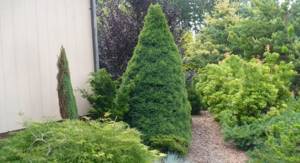
Caring for Rainbow End is no different from caring for representatives of other varieties. It is important to timely apply complex fertilizers, mulching, regular watering, cultivation, weeding, and avoid sodding. This variety is resistant to frost, but sensitive to air pollution and smoke.
The variety was bred in Poland. Today it is not widely used in landscape design. Rainbow End is in demand mainly only among professional gardeners who seek to control the size of their gardens from the very beginning of design. Can be grown as a container crop or used for contrasting plantings.
